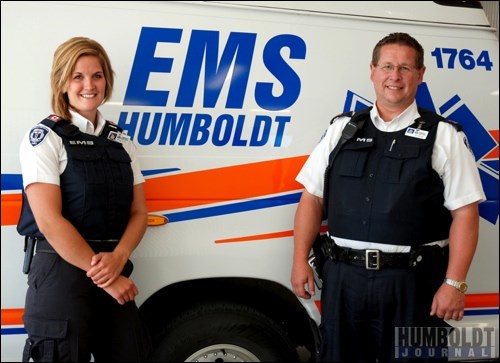You may have noticed that ambulance crews in Humboldt are sporting a new accessory these days as part of their uniform.
This summer, paramedics with Humboldt and District Ambulance Service (HDAS) began wearing ballistic vests - vests that are bullet- and stab-proof.
There are a couple of reasons for this, explained Derek Dagenais, Advanced Care Paramedic with HDAS.
"Number one, it's become more commonplace in Saskatchewan for EMS (emergency medical services) personnel (to wear the vests)," he said.
Rural services are using them, as are those located in Prince Albert, Saskatoon and Regina. All SIAST students studying to be paramedics also wear them while they are doing their training, he added.
Secondly, there seems to be a need for EMS personnel in Humboldt to wear them.
"I've always liked the idea, had it in the back of my mind," Dagenais said, simply due to the nature of their work.
And in the past couple of years, there have been incidents that have caused some concerns about staff safety.
After the last major incident, it was decided that to go without vests was not worth the risk.
The 10 paramedics on staff with HDAS were given the option to wear the vests or not, said Dagenais, and the majority decided to do so.
By wearing the vests, they will be more protected from firearms, slashing and stabbing, and blunt force trauma, which means they are protected if they get into a crash.
"With the number of miles we run, that's an added bonus," Dagenais said.
"We're not living in fear, but we have had incidents that concern us," he noted. "It's a proactive move to ensure the safety of the staff."
Humboldt is not a terribly dangerous place to live, and Dagenais doesn't want the vests to give people that impression.
However, there are things happening that most people living here have no idea about, as they cannot be reported due to privacy issues or other reasons which tie their hands.
"Things are happening in Humboldt even if you don't see them in the Journal or on the Internet," he said.
"For the last number of years, we've been dealing with more people under the influence of drugs and alcohol," he stated, and people with medical issues that make them aggressive - people suffering from things like head injuries or seizures.
And in one year, there were two assaults on HDAS staff that resulted in criminal charges.
The last assault involved one crew being bear-sprayed while out on a call.
That was the final straw for HDAS, making up their minds to get vests for their staff. It has also been something that has resulted in more EMS personnel around the province talking about incidents where they have been kicked and punched in the course of their duties.
Because of the nature of their work, there is always the potential for danger whenever EMS personnel respond to a call.
"There's a certain amount of risk you take with the job. People don't realize the things we expose ourselves to, even infections," Dagenais said.
They risk being hit by cars when helping victims of motor vehicle crashes on the highways, and even in Humboldt, people have tried to stab and hit paramedics while they go about their duties, helping people - sometimes people who have nothing to do with the incident they are dealing with.
Lots of times, there's no reason behind people doing these things, Dagenais noted - they don't make any sense. That unpredictability is another reason why the vests make sense.
Paramedics also go to people's homes, which means they are walking into situations that could be dangerous and can find themselves in a vulnerable position.
"It's hard for people to understand... even when we are there to help, they can be aggressive because they aren't sure what is going on," Dagenais explained.
"When you're leaning over someone, it's dark, and they don't realize they've had a seizure, they can be very aggressive," he said.
Though it's their policy that they don't go into a scene where there is danger without RCMP, the police don't accompany paramedics to every call.
However, sometimes, due to the way an incident is reported, EMS find themselves in a dangerous situation without the police to back them up.
In these cases, things are called in as something more innocuous than what they truly are because people don't want the police involved, or are not fully aware of what is happening.
EMS could be called to help someone who simply has a decreased level of consciousness, then find the reason for the lost consciousness is a danger to them.
Dagenais compared the vests to hard hats at a construction site. Everyone wears a hard hat, he said, and no one questions it, but how many times are people actually hit on the head at the site?
"It's better to be proactive," he said.




